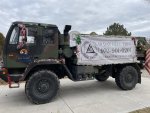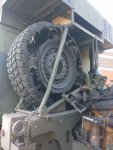Ronmar
Well-known member
- 4,450
- 8,356
- 113
- Location
- Port angeles wa
Or you have gotten air in the cylinder. Because of the angle that cylinder sets at it is succeptible to the inconsistent flow caused by air pockets in the oil. This can cause the cylinder to lock in the up position as the load/safety check gets pushed against its seat and held there by the force created by a trapped air pocket. Tge safety is tgere to catch the load if you blow a line or break a fitting. It is supposed to leak away eventually and unlock but the passages that allow that may clog over time.
You can sometimes unlock the check by alternately shifting between raise and lower while pumping. Look on youtube under username rronmar (that is one of my videos up a few comments). I did a video on manually releasing that safety check. You disconnect the rear facing fitting on the tire cylinder, fish out the little debris screen then you can slide a thin probe in there to push the check ball off the seat and release the trapped pressure in the cylinder. Replace the screen and fitting and you should be able to lower the tire...
You can sometimes unlock the check by alternately shifting between raise and lower while pumping. Look on youtube under username rronmar (that is one of my videos up a few comments). I did a video on manually releasing that safety check. You disconnect the rear facing fitting on the tire cylinder, fish out the little debris screen then you can slide a thin probe in there to push the check ball off the seat and release the trapped pressure in the cylinder. Replace the screen and fitting and you should be able to lower the tire...





